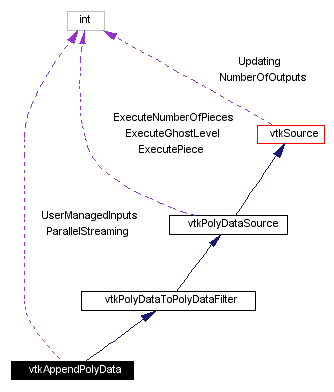Main Page Class Hierarchy Alphabetical List Compound List File List Compound Members File Members Related Pages
vtkAppendPolyData Class Reference
appends one or more polygonal datasets together.
More...
#include <vtkAppendPolyData.h>
Inheritance diagram for vtkAppendPolyData:
 [legend]Collaboration diagram for vtkAppendPolyData:
[legend]Collaboration diagram for vtkAppendPolyData: [legend]List of all members.
[legend]List of all members.
Detailed Description
appends one or more polygonal datasets together.
-
Date:
-
2000/12/10 20:08:30
-
Revision:
-
1.43
vtkAppendPolyData is a filter that appends one of more polygonal datasets into a single polygonal dataset. All geometry is extracted and appended, but point and cell attributes (i.e., scalars, vectors, normals) are extracted and appended only if all datasets have the point and/or cell attributes available. (For example, if one dataset has point scalars but another does not, point scalars will not be appended.)
-
See also:
-
vtkAppendFilter
-
Examples:
-
vtkAppendPolyData (examples)
Definition at line 65 of file vtkAppendPolyData.h.
Constructor & Destructor Documentation
| vtkAppendPolyData::vtkAppendPolyData |
( |
|
) |
[protected] |
|
| vtkAppendPolyData::~vtkAppendPolyData |
( |
|
) |
[protected] |
|
| vtkAppendPolyData::vtkAppendPolyData |
( |
const vtkAppendPolyData & |
|
) |
[inline, protected] |
|
Member Function Documentation
| vtkAppendPolyData* vtkAppendPolyData::New |
( |
|
) |
[static] |
|
|
|
Instantiate object with no start, end, or progress methods.
Reimplemented from vtkPolyDataSource. |
| virtual const char* vtkAppendPolyData::GetClassName |
( |
|
) |
[virtual] |
|
| int vtkAppendPolyData::IsTypeOf |
( |
const char * |
type |
) |
[static] |
|
|
|
Return 1 if this class type is the same type of (or a subclass of) the named class. Returns 0 otherwise. This method works in combination with vtkTypeMacro found in vtkSetGet.h.
Reimplemented from vtkPolyDataToPolyDataFilter. |
| virtual int vtkAppendPolyData::IsA |
( |
const char * |
type |
) |
[virtual] |
|
|
|
Return 1 if this class is the same type of (or a subclass of) the named class. Returns 0 otherwise. This method works in combination with vtkTypeMacro found in vtkSetGet.h.
Reimplemented from vtkPolyDataToPolyDataFilter. |
| vtkAppendPolyData* vtkAppendPolyData::SafeDownCast |
( |
vtkObject * |
o |
) |
[static] |
|
| void vtkAppendPolyData::PrintSelf |
( |
ostream & |
os, |
|
|
vtkIndent |
indent |
|
) |
[virtual] |
|
|
|
Methods invoked by print to print information about the object including superclasses. Typically not called by the user (use Print() instead) but used in the hierarchical print process to combine the output of several classes.
Reimplemented from vtkSource. |
| virtual void vtkAppendPolyData::SetUserManagedInputs |
( |
int |
|
) |
[virtual] |
|
|
|
UserManagedInputs allows the user to set inputs by number instead of using the AddInput/RemoveInput functions. Calls to SetNumberOfInputs/SetInputByNumber should not be mixed with calls to AddInput/RemoveInput. By default, UserManagedInputs is false. |
| virtual int vtkAppendPolyData::GetUserManagedInputs |
( |
|
) |
[virtual] |
|
| virtual void vtkAppendPolyData::UserManagedInputsOn |
( |
|
) |
[virtual] |
|
| virtual void vtkAppendPolyData::UserManagedInputsOff |
( |
|
) |
[virtual] |
|
|
|
Add a dataset to the list of data to append. Should not be used when UserManagedInputs is true, use SetInputByNumber instead. |
|
|
Remove a dataset from the list of data to append. Should not be used when UserManagedInputs is true, use SetInputByNumber (NULL) instead. |
|
|
Get any input of this filter. |
| void vtkAppendPolyData::SetNumberOfInputs |
( |
int |
num |
) |
|
|
|
|
Directly set(allocate) number of inputs, should only be used when UserManagedInputs is true.
Reimplemented from vtkProcessObject. |
| void vtkAppendPolyData::SetInputByNumber |
( |
int |
num, |
|
|
vtkPolyData * |
input |
|
) |
|
|
| virtual void vtkAppendPolyData::SetParallelStreaming |
( |
int |
|
) |
[virtual] |
|
|
|
ParallelStreaming is for a particular application. It causes this filter to ask for a different piece from each of its inputs. If all the inputs are the same, then the output of this append filter is the whole dataset pieced back together. Duplicate points are create along the seams. The purpose of this feature is to get data parallelism at a course scale. Each of the inputs can be generated in a different process at the same time. |
| virtual int vtkAppendPolyData::GetParallelStreaming |
( |
|
) |
[virtual] |
|
| virtual void vtkAppendPolyData::ParallelStreamingOn |
( |
|
) |
[virtual] |
|
| virtual void vtkAppendPolyData::ParallelStreamingOff |
( |
|
) |
[virtual] |
|
| void vtkAppendPolyData::operator= |
( |
const vtkAppendPolyData & |
|
) |
[inline, protected] |
|
| void vtkAppendPolyData::Execute |
( |
|
) |
[protected, virtual] |
|
| void vtkAppendPolyData::ComputeInputUpdateExtents |
( |
vtkDataObject * |
output |
) |
[protected, virtual] |
|
|
|
What is the input update extent that is required to produce the desired output? By default, the whole input is always required but this is overridden in many subclasses.
Reimplemented from vtkPolyDataSource. |
| int* vtkAppendPolyData::AppendCells |
( |
int * |
pDest, |
|
|
vtkCellArray * |
src, |
|
|
int |
offset |
|
) |
[protected] |
|
Member Data Documentation
int vtkAppendPolyData::ParallelStreaming [protected]
|
|
The documentation for this class was generated from the following file:
Generated on Wed Nov 21 12:46:25 2001 for VTK by
 1.2.11.1 written by Dimitri van Heesch,
© 1997-2001
1.2.11.1 written by Dimitri van Heesch,
© 1997-2001



 1.2.11.1 written by Dimitri van Heesch,
© 1997-2001
1.2.11.1 written by Dimitri van Heesch,
© 1997-2001